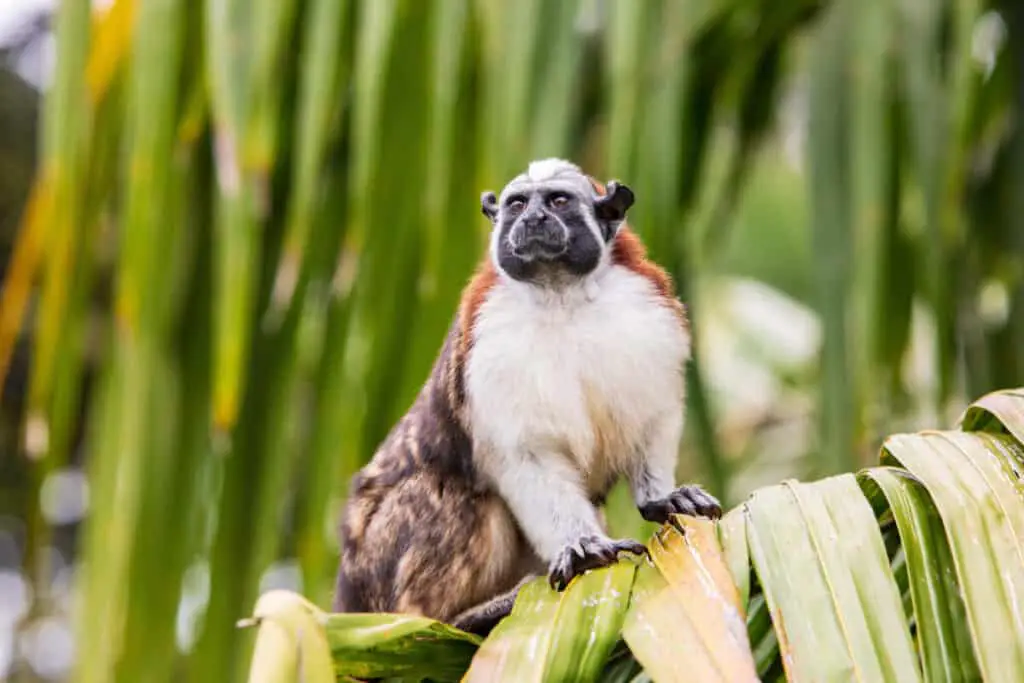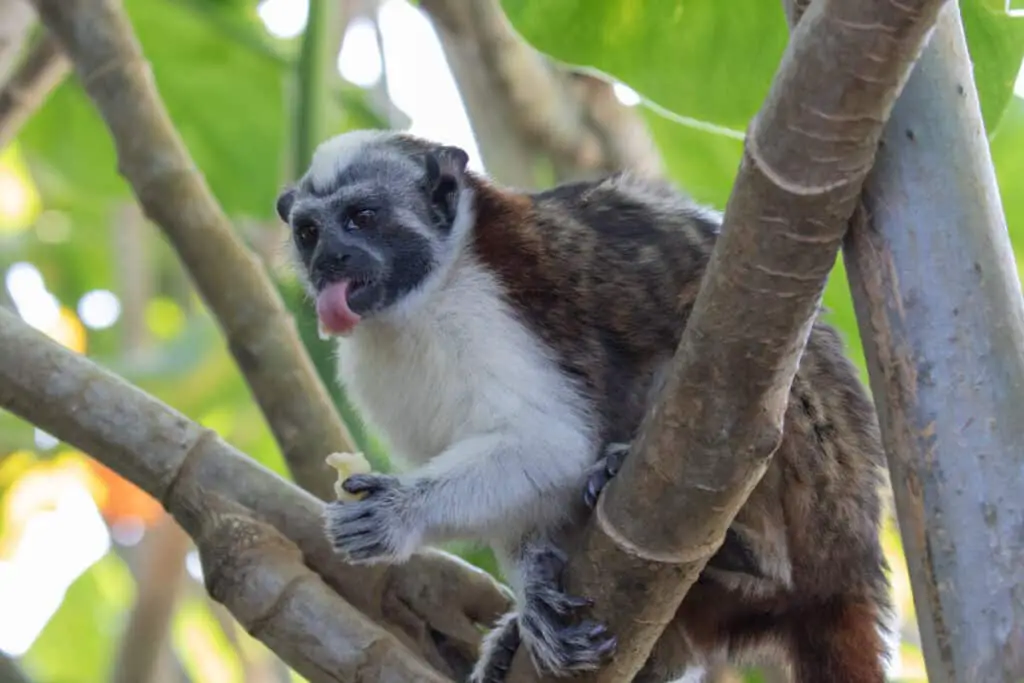Geoffroy’s tamarin is a small, arboreal primate that belongs to the family Callitrichidae. This species inhabits the tropical rainforests of South America and is known for its distinctive physical features, including its black-and-white fur pattern and claw-like nails.
This primate plays an important ecological role in the ecosystem as it serves both as a predator and prey item.
However, despite their importance in maintaining balance within their habitat, this species faces several threats such as deforestation and poaching activities which have resulted in population decline over time.
As such, understanding the biology and behavior of Geoffroy’s tamarin has become crucial for conservation efforts aimed at protecting these primates from extinction.

Physical Characteristics Of Geoffroy’s Tamarin
The Geoffroy’s Tamarin, also known as Saguinus geoffroyi, is a small New World monkey that belongs to the Callitrichidae family. These primates are characterized by their unique physical appearance and social behavior.
Their fur is predominantly black with white markings on their forehead and muzzle. They have long tails that are not prehensile but help them maintain balance while leaping between trees in their natural habitat.
Geoffroy’s Tamarins are omnivores, meaning they consume both plants and animals. Insects form the majority of their diet preferences, including ants, spiders, grasshoppers, crickets, caterpillars, and beetles. However, they also feed on fruits, nectar from flowers, tree sap, and occasionally small vertebrates like lizards or frogs.
When it comes to breeding patterns, these primates typically mate for life. Both males and females participate equally in parenting duties after giving birth to twins or triplets each year.
This primate species has been extensively studied by scientists due to its intriguing social organization and communication abilities.
Habitat And Distribution
The Geoffroy’s Tamarin is a small New World monkey that can be found in the rainforests of South America. They are primarily distributed throughout northern Argentina, eastern Brazil, Paraguay, and Uruguay.
These primates inhabit both primary forests and secondary growth areas. However, due to forest fragmentation caused by human impact such as deforestation, their habitat has become increasingly limited. Rainforest fragmentation poses a significant threat to the survival of the Geoffroy’s Tamarin population.
As humans continue to destroy large portions of natural habitats for agricultural or urban development purposes, these primates lose access to essential resources like food and shelter. This loss leads to competition among individuals within the same species and increases their vulnerability to predators.
The situation is exacerbated when isolated populations cannot disperse effectively between fragmented habitats leading to genetic diversity reduction. Ultimately, it highlights our need for conservation efforts focused on protecting the remaining natural habitats where they live and creating corridors connecting different fragments for tamarin populations’ movement across landscapes.
Ecological Importance In The Ecosystem
The habitat and distribution of Geoffroy’s tamarin are primarily found in the Amazon basin, ranging from eastern Colombia to northern Bolivia. These primates inhabit various ecosystems such as tropical rainforests, swamps, and secondary forests. They have adapted well to their environment by being predominantly arboreal, meaning they spend most of their time in trees. Their small size allows them to move swiftly through branches while feeding on fruits, insects, spiders, and nectar.
Despite their adaptability to a wide range of environments, the ecological niche of Geoffroy’s tamarin is threatened due to habitat loss caused by deforestation. The clearing of land for agricultural purposes has resulted in fragmentation of the forested areas where these primates live and reduced food availability.
Additionally, hunting poses another threat since humans hunt these monkeys for bushmeat or capture them for pet trade. As a result, there is a need for conservation efforts aimed at protecting their habitats and reducing human-wildlife conflict.
Understanding their ecological importance within the ecosystem can aid in developing effective strategies that ensure this species’ survival.
Threats To Survival
One of the main threats to survival for Geoffroy’s tamarin is human impact. Deforestation and habitat fragmentation caused by human activities have led to a decline in the population of this species.
As their natural habitats are destroyed, they become more vulnerable to predators and other threats. Predator-prey interactions also play a significant role in the survival of Geoffroy’s tamarin.
These primates are preyed upon by birds of prey, snakes, and larger mammals such as ocelots and jaguars. The loss of trees due to deforestation makes it easier for these predators to hunt them down, leading to further declines in their population.
In addition, hunting by humans has also contributed to the reduction in numbers of this species. Efforts must be made to address these threats if we want to ensure the continued survival of Geoffroy’s tamarin in its natural habitat.
Family Callitrichidae: The Miniature Wonders of Callitrichids
Conservation Efforts
Threats to the survival of Geoffroy’s tamarin are numerous and significant. Habitat loss due to deforestation, agricultural expansion, and urbanization is one of the primary threats faced by this primate species.
Additionally, hunting for bushmeat and capture for use in biomedical research also threaten their populations. These factors have led to a decline in population numbers over the years, making conservation efforts crucial.
To combat these threats, various organizations have implemented several conservation measures aimed at protecting Geoffroy’s tamarin populations. One such measure involves community involvement through education programs that raise awareness about the importance of conserving these primates’ habitats.
Furthermore, funding sources from governmental agencies and non-governmental organizations support conservation initiatives like habitat restoration projects and anti-poaching patrols to protect wildlife from illegal hunters. The collaboration between local communities and conservation groups has helped establish protected areas where human activities are limited or banned altogether thus securing safe havens for threatened species like Geoffroy’s tamarin.
Behavior And Social Structure
What drives group dynamics and communication patterns in Geoffroy’s tamarin? Observations of this species suggest that its social structure is built on cooperative behavior, with individuals working together to achieve common goals.
Tamarins are known for their vocalizations, including a wide range of calls and songs used for different purposes, such as warning others about predators or calling out to potential mates. These vocalizations play an important role in maintaining social cohesion within the group.
One notable aspect of Geoffroy’s tamarin behavior is their use of scent marking to communicate with each other. This involves rubbing glands on their foreheads against objects in their environment, leaving behind chemical signals that convey information about an individual’s sex, age, and reproductive status.
Scent marking helps establish territories and reduces aggression between groups by signaling boundaries without direct conflict. Overall, these various forms of communication help maintain stable relationships among members of the group, promoting cooperation and reducing stress levels.

Conclusion
Geoffroy’s Tamarin is a small monkey that resides in the rainforests of South America. With its black and white fur, it stands out among the lush greenery that surrounds it. It has a crucial role to play in its ecosystem as it helps disperse seeds from fruits consumed during their daily diet.
Unfortunately, human activities such as deforestation and illegal pet trade pose serious threats to Geoffroy’s Tamarin population. Despite conservation efforts put forth by local communities and organizations alike, these primates remain endangered. They serve as symbols for all species facing similar struggles at the hands of human actions.
As we work towards protecting the environment and all creatures within it, let us remember the significance of each creature in maintaining balance. The survival of Geoffroy’s Tamarin depends on our ability to acknowledge their importance and take necessary measures to ensure their existence alongside ours.
May they continue serving as emblems for all beings struggling for preservation amidst modern-day challenges.

